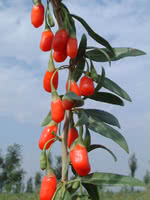Mon-Fri 9am - 5pm Mountain time
Ninebark vs Goji Berry
Physocarpus opulifolius
Lycium barbarum
CUSTOM GROW
NOT AVAILABLE THIS SEASON - MIGHT RETURN
Ninebark is a small, multi-stemmed shrub, that is used to add texture or colour to any yard.
It features flaky, cinnamon-brown bark, attractive white flowers, and long, maple-like leaves.
Goji Berry is a woody, deciduous perennial known for its hearty, bright orange-red berries. It typically produces light lavender flowers from June through September, with fruit maturation taking place between August and October.
Goji Berry berries are delicious, nutrient rich, high in antioxidants, and are often called a super fruit. Many describe their flavour as being like a tart cherry tomato.

